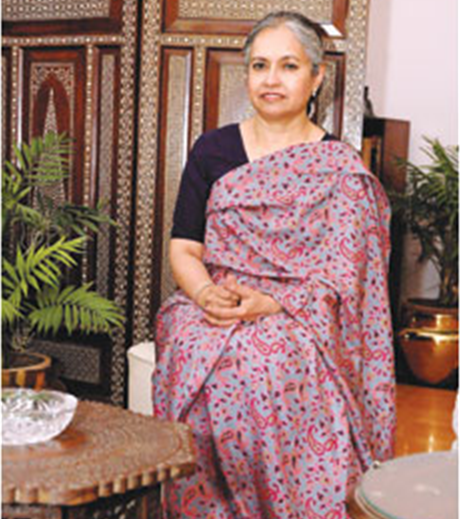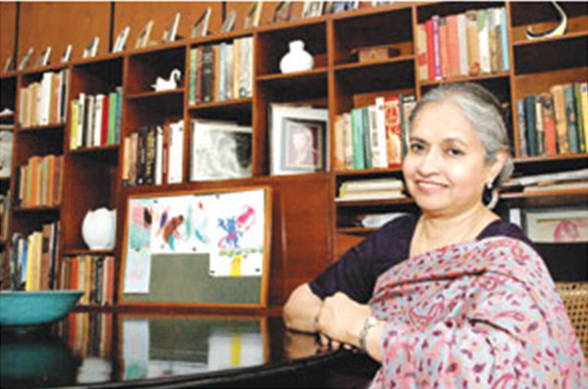Naz Ikramullah
This is a collection of articles archived for the excellence of their content. Readers will be able to edit existing articles and post new articles directly |
Naz Ikramullah
Artistically inclined
By Fouzia Mapara
Naz Ikramullah’s film on the cultural life of Muslim women of the subcontinent was an attempt to rectify the preconceived western notion about the women of Pakistan and India being suppressed. While she portrayed the modern women of this part of the world –– who work outside home, are homemakers and integrate tradition into their modern living –– the film also brought to light revelations about the cultural amalgamation that has taken place over a period of time in the subcontinent
Like a migratory bird, Naz Ikramullah spends the Canadian winter months in Karachi and the unbearably hot Karachi summer in Canada, enjoying the best of both worlds.
Ikramullah, painter and the elder daughter of the late Begum Shaista Ikramullah, was born in London, when her father Mohammad Ikramullah was deputy trade commissioner of India, and her mother was studying for her PhD.
Despite spending her early life all over India and presently living in Canada, she feels that Karachi is where she belongs. “Since my brother and sister passed away, it is in Karachi that I come across people with whom they had spent time with, so I feel that more than anywhere else in the world, a part of them is still here. When I meet people here, it’s a joy to be able to talk about my family and share stories.”
The link to Karachi was established when her father Mohammad Ikramullah arrived here on August 11, 1947 with Naz’s younger and only brother Enam, and opened the new country’s foreign office. During the upheaval of Partition, the two older daughters, Salma and Naz, who were only 10 and nine years old at the time, were in Lucknow, while their mother was to give birth to her youngest daughter, Sarwath, in Calcutta.
The older sisters were to form a bond that made them appear, as Naz says, like twins. In 2003 the sisters spent some time with each other in Benaras shortly after which unfortunately Salma passed away.
She misses her siblings and discovered that she was unable to paint for some time. She was looking forward to returning to Canada in March as it would mark a closure of the present chapter. “I am going to work on expanding some miniatures that I did earlier. In Ottawa, the environment is very conducive to express what onae has been inspired by in this part of the world. You can work undisturbed for hours and specially make time if you want to see people,” she says.
Naz Ikramullah has lived in Canada since the 1970s and has made a niche for herself within the established art community there. She has shown and worked with art consultant Edward F. Monagham for many years, and been in art education in Canada almost since the very early years of her arrival there. At present she teaches at the Ottawa School of Art.
She has also taught art as short courses to younger children belonging to different cultures and ethnic origins and feels that each student has a special contribution to make.
Her film on the cultural life of Muslim women of the subcontinent was an attempt to rectify the preconceived western notion about the women of Pakistan and India being suppressed. While she portrayed the modern women of this part of the world –– who work outside home, are homemakers and integrate tradition into their modern living –– the film also brought to light revelations about the cultural amalgamation that has taken place over a period of time in the subcontinent.
“It was hard work and I am not a filmmaker. I researched in Pakistan, India, the Victoria and AlbertMuseum but visual components remained a challenge,” says Ikramullah.
The film which was shown in Karachi as well, was actually meant for people in Canada and especially the young generation who are ignorant of their ancestors and their achievements in art and culture. Anything to do with Pakistan is misconstrued as Taliban influenced.
Inclusion of Indian women alongside Pakistani women in her research and projection not only added content but was also valuable as people of the entire region share the same values, culture, art and history.
“There are so many things that I discovered which were deep-rooted in the traditions of the subcontinent that did not originate in the region but were brought through the various conquests and invasions. For instance the mystifying origins of the nath or the symbolic sindhoor ––– used to adorn the hair parting of Hindu married women ––– was substituted by Muslims with sandal according to a verse by Mir Anees. Similarly, the motive of kairi (the paisley), perhaps originated from bent-over cypress trees and mehndi was used by Arabs for centuries.”
Naz’s deep-rooted interest and loyalty to this culture goes back to her childhood that she spent in India. She remembers Partition very well. “There were tense situations and many people who became famous later used to come to our house for meetings.”
In 1940, her home was on Hailey Road in Delhi and she cherishes her memories of her education at ‘Aunty’s’ and her German teacher, Mrs Gauba, who taught them lessons that would stay with her throughout her life. “We were taught the Hindi script, writing on a ‘takhti’, music, dance and the history of India, the Rajas and the Mughals which was different to what was being taught in the other schools during the British Raj.”
Naz’s mother, Begum Ikramullah whose maiden name was Shaista Akhtar Bano was a profound influence, and was one of the key women figures involved in the struggle for independence. She led a dynamic life, authored several books and later became the ambassador to Morocco from 1964-67.
So what is it like to be the daughter of such an illustrious woman? “My mother and actually both my parents always stressed that I should get a degree first and then pursue art school training,” says Naz Ikramullah. She, however, realised years later that without a degree it would have been difficult to settle down in Canada.
She fondly shares memories of her mother teaching them Urdu language and literature during their holidays in Ziarat, which she and her siblings would resent but later realised the value of a well-rounded education and upbringing they were fortunate to have had.
“There would be bait baazi, at which I was not so good and would sit with my sister who was much better at it.” Later, following in the footsteps of her mother, Naz and her husband decided to send their daughter to Aligarh for four years to learn Urdu.
What is the language of her thoughts? “I think in English, although when I was younger I would pray for all the legitimate things in Urdu but in English, for all the things that I was not allowed to do,” she admits with a smile.
“Amma would say you can’t dance, its not part of our culture, and I declined the invitation for the wedding of Karim Aga Khan V because I refused to sit there and tap my foot!”
Although several artists have influenced her work, sometimes it may seem difficult to point a signature Naz Ikramullah piece. There may be strong oriental overtures as people in Canada point out but you may suddenly come across a piece that is very European in style. Ikramullah’s work is reflective of her family’s political affiliation and her vast exposure to distant cultures.
She builds on layers of painting, print making, collage, bit of Photoshop thrown in. Naz Ikramullah’s mixed-media works portray an experienced lithographer and a sensitive artist who imbibes from her environment whether it is today’s paper, a book she has read, a film she saw, an image that she captured subconsciously or consciously which does make her work dated at times but no less mystifying.
“Anything can be my inspiration. A TV play like, something happening in Vietnam, or Palestine. My work depicts my moods.” Some of her work depicts an inner trail of thoughts, sometimes private, like every human mind processes thoughts, but not many have the ability to transfer the blend on to canvas.
Seeing a collage with selections from Urdu poetry I commented that this should have been bigger instead of a miniature so I could have read the words more easily, she was quick to remark, “That is deliberate, they are my private thoughts and I don’t want people to read them.”
Her work has been shown at venues as diverse as the Royal Portrait Society in 1958, at the Woodstock Gallery, London, in 1963, at the Bharat Bhavan International Biennial of Prints, in Bhopal in 1995, at The Barbican in 1989, the Art Heritage Gallery, New Delhi, in 1989 and at the Crymroza Gallery, Bombay, in 1990, among many others.
My World, a Photoshop print, is perhaps the most enduring image of her home in Karachi, a lifetime of memories she chooses to revisit and one which she continuously comes back to in real life.
Fragments from her life, reflect moments full of humour and love with her sister Salma, entwined with other incidental details like conversations from the past, a certain smell recaptured, or a mood remembered, a political stance reiterated, all expressed beyond cultures and geographic limitations.

